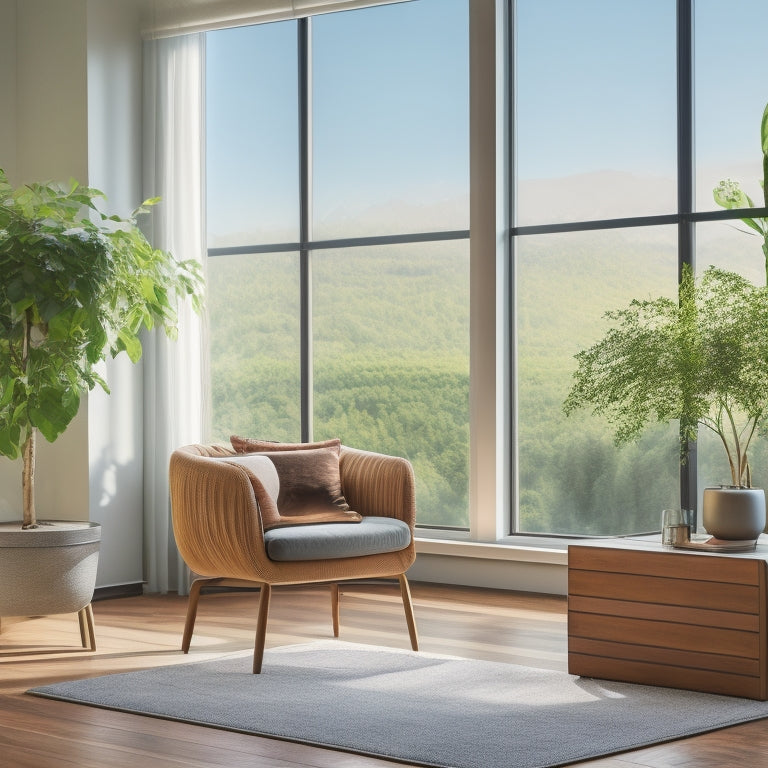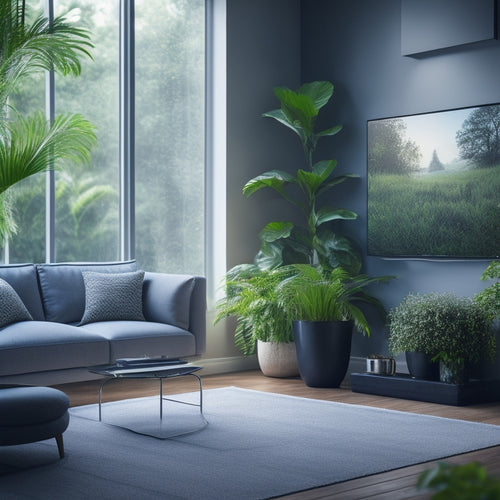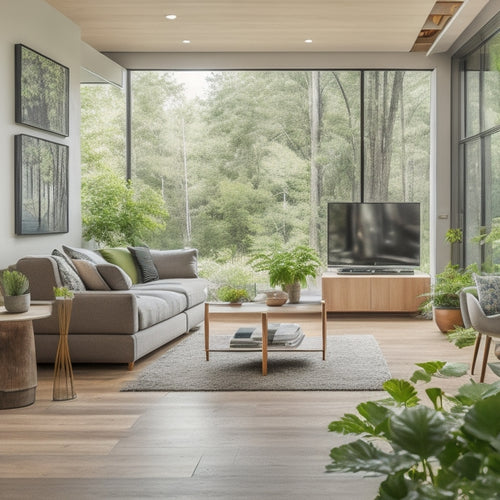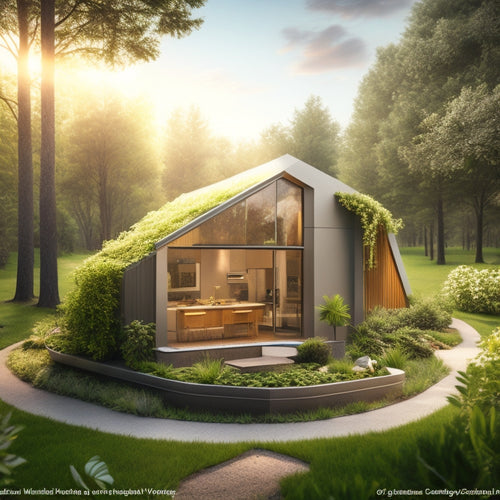
7 Smart Air Purification Hacks for Energy-Savvy Homes
Share
You can notably improve your indoor air quality while minimizing energy consumption by implementing strategic air purification hacks in your energy-savvy home. Enhance air purifier efficiency by positioning them in high-circulation areas and selecting filters based on space size. Utilize smart sensor technology to monitor environmental factors and enable real-time adjustments. Optimize filter replacement schedules and make use of energy-efficient modes to reduce waste and save on utility bills. Employ natural ventilation methods, integrate with smart home systems, and monitor air quality remotely to create a comprehensive approach to home energy management and sustainability. By adopting these hacks, you'll be well on your way to a healthier, more energy-efficient living space, and there's even more to investigate when it comes to maximizing your air purification system's potential.
Key Takeaways
- Position air purifiers in high-air-circulation areas and select filters based on space size for optimal purification.
- Replace filters every 3-6 months and conduct monthly electrical connection checks to maintain performance and reduce energy consumption.
- Utilize energy-efficient modes, such as auto mode and eco-friendly operation features, to save energy and reduce utility bills.
- Leverage smart sensor technology to monitor environmental factors and adjust air purifier settings in real-time for improved air quality.
- Integrate air purifiers with smart home systems for automated climate control, remote monitoring, and centralized management.
Boost Air Purifier Efficiency
By positioning your air purifier strategically throughout your home, you can markedly enhance its efficiency.
Opt for areas with high air circulation, such as living rooms or hallways, to maximize air purification.
Consider the type of filter you're using, as some are more effective in smaller, enclosed spaces, while others excel in larger areas.
For instance, incorporating fast charging infrastructure in your air purification system can lead to improved energy efficiency, much like how fast charging stations can recharge up to 80% in under 30 minutes.
By leveraging energy-efficient solutions, you can reduce your carbon footprint and create a more sustainable home environment.
Employ a combination of filter types and placement strategies to create a thorough air purification system that works in harmony with your home's unique layout and needs.
Leverage Smart Sensor Technology
You've refined your air purifier's placement and filter type to maximize efficiency, but there's more to creating a seamless air purification system.
Now, it's time to utilize smart sensor technology to take your air quality to the next level. Strategically placing sensors in your home allows you to monitor environmental factors that impact air quality, such as humidity, temperature, and pollutant levels.
This data enables your air purifier to adjust its settings for peak performance.
| Sensor Placement | Environmental Factors Monitored |
| Living Room | Temperature, Humidity, Particulate Matter (PM) |
| Kitchen | Carbon Monoxide (CO), Nitrogen Dioxide (NO2) |
| Bedroom | Volatile Organic Compounds (VOCs), Ozone (O3) |
| Hallway | Air Pressure, Pollen Counts |
| Outdoor | Weather Forecast, Air Quality Index (AQI)
Optimize Filter Replacement Schedules
Most air purifiers require filter replacements every 3-6 months, but this can vary greatly depending on your specific unit and usage.
Regular cleaning and maintenance practices, such as monthly checks on electrical connections, can also impact the performance and lifespan of your air purifier's filter.
To optimize your filter replacement schedule, it's crucial to understand the filter lifespan of your air purifier. Check your user manual or manufacturer's website for guidance on the recommended replacement period.
Additionally, look out for replacement indicators such as a filter change indicator light or a decrease in air quality.
By keeping track of your filter's performance and replacing it as needed, you'll guarantee your air purifier continues to run efficiently and effectively.
This won't only improve indoor air quality but also reduce energy consumption and prolong the lifespan of your device.
Harness Natural Ventilation Methods
While maintaining your air purifier is essential, it's equally important to employ natural ventilation methods to create a well-rounded approach to indoor air quality.
By doing so, you'll reduce your reliance on mechanical systems and create a healthier living space. Adopting eco-friendly solutions, such as incorporating solar panel kits for energy efficiency, can also contribute to a more sustainable lifestyle.
To capture natural ventilation, consider the following strategies:
-
Optimize window placement: Strategically place windows on opposite sides of your home to create cross ventilation techniques, allowing fresh air to enter and stale air to escape.
-
Use clerestory windows: Install clerestory windows to bring in natural light and improve air circulation, reducing the need for artificial lighting and mechanical ventilation.
-
Employ passive design: Design your home with passive ventilation in mind, using features like solar chimneys and wind towers to naturally ventilate your space.
Utilize Energy-Efficient Modes
You can optimize your air purifier's performance by utilizing energy-efficient modes that won't break the bank.
By enabling auto mode, you allow your device to adjust its fan speed according to the air quality, ensuring you're not wasting energy when the air is clean.
Additionally, look for eco-friendly operation and power save features that can greatly reduce your energy consumption without compromising on air quality.
To further minimize energy losses, consider selecting energy-efficient equipment with high energy ratings, such as those found in Level 1 charging equipment, which can achieve 95%+ efficiency.
Auto Mode Enabled
By opting for air purifiers with auto mode enabled, you're letting the device take charge of optimizing its performance in real-time, which translates to significant energy savings over time.
This mode allows the air purifier to adjust its fan speed according to the air quality, guaranteeing that it uses just the right amount of energy to maintain a healthy environment.
Additionally, adopting energy-efficient solutions like solar-powered EV charging stations renewable energy can also contribute to a sustainable future. By reducing our reliance on fossil fuels, we can minimize our carbon footprint and create a healthier environment.
-
Optimized energy consumption: The device adjusts its power usage based on air quality, reducing energy waste and saving you money on your utility bills.
-
Improved air quality: Auto mode guarantees that the air purifier is always working at its best to remove pollutants and allergens, giving you fresher, healthier air.
-
Convenience: With auto mode, you don't need to constantly monitor and adjust the air purifier's settings, giving you more freedom to focus on other things.
Eco-Friendly Operation
The pursuit of eco-friendly operation is an essential aspect of creating an energy-savvy home, and utilizing energy-efficient modes is a significant step in this direction.
You can achieve this by opting for air purifiers made from sustainable materials that promote energy conservation. Look for devices with energy-saving features, such as low-power modes or eco-modes, which reduce energy consumption without compromising performance.
Additionally, consider air purifiers with smart sensors that automatically adjust their power consumption based on air quality.
Power Save Feature
Air purification devices equipped with power save features can markedly reduce energy consumption, making them an attractive option for energy-savvy homeowners.
By utilizing energy-efficient modes, you can minimize your power consumption and lower your energy bills.
-
Auto-mode: This feature adjusts fan speed according to air quality, ensuring you're not wasting energy when the air is clean.
-
Eco-mode: This setting reduces power consumption during off-peak hours or when the air purifier isn't in use.
-
Smart sensors: These sensors detect when you're not in the room and automatically switch to a low-power mode, saving energy and reducing waste.
When shopping for an air purifier, look for devices with high energy ratings and power save features to maximize your energy savings.
Integrate With Smart Home Systems
As you automate your home's climate control, lighting, and security systems, consider integrating your air purification system with these smart features to create a seamless and energy-efficient ecosystem.
With smart home integration, you can control your air purifier alongside other devices using voice commands or user-friendly interfaces. IoT compatibility guarantees seamless connectivity between devices, allowing you to schedule automated settings and enjoy centralized management.
Energy monitoring features help you optimize your system's performance and reduce energy waste. Plus, with remote access, you can adjust settings from anywhere, assuring your home remains healthy and comfortable whenever you need it to be.
Monitor Air Quality Remotely
You're taking control of your indoor air quality to a whole new level by integrating your air purifier with your smart home system.
With remote monitoring, you'll stay on top of your air quality 24/7, no matter where you are.
Here are three ways remote monitoring enables you:
-
Real-time alerts: Receive instant notifications when air quality drops, so you can take action to purify your air.
-
Air quality metrics: Track detailed metrics on pollutants, humidity, and temperature to optimize your air purification strategy.
-
Remote adjustments: Adjust your air purifier's settings from your phone or tablet to guarantee your air stays clean and fresh.
Frequently Asked Questions
Can Air Purifiers Remove All Types of Pollutants From the Air?
You breathe easy, but can air purifiers really capture all unwanted guests in your air? While they can't eliminate every pollutant, you'll find that different filter types can tackle various pollutant sources, like dust, gases, and germs, offering a healthier indoor haven.
Do Smart Air Purifiers Require Wi-Fi Connectivity to Function?
You'll be relieved to know that not all smart air purifiers require Wi-Fi connectivity to function; some offer alternative connectivity options, like Bluetooth or manual controls, allowing you to enjoy smart features without sacrificing your digital freedom.
Are Air Purifiers Suitable for People With Respiratory Issues?
You'll find that air purifiers can be a revolutionary solution for people with respiratory issues, offering significant health benefits by removing pollutants and allergens. Look for purifiers with HEPA or activated carbon filters to breathe easier and live freer.
Can I Use Air Purifiers in Conjunction With HVAC Systems?
You can seamlessly integrate air purifiers into your existing HVAC system, ensuring ideal air quality while maintaining energy efficiency, and rest assured that they'll work in harmony to create a healthier, more comfortable living space.
Are Energy-Efficient Air Purifiers More Expensive Than Traditional Models?
You'll find that energy-efficient air purifiers may cost more upfront, but they'll save you money in the long run through reduced energy consumption, making them a worthwhile investment for your wallet and the planet.
Related Posts
-

7 Best Home Hydrogen Fuel Cells for Clean Power
You're considering adopting hydrogen fuel cells for clean power at home, but you want to know the best options. Reput...
-

Why EVs Inspire Earth-Conscious Home Design Choices
As you shift to an electric vehicle, you're not just switching to a greener ride, you're igniting a broader commitmen...
-

10 Best Sustainable Waste Management Solutions for Green Homes
You're likely unaware that the average green home generates over 2 kilograms of waste daily, but with the right susta...


